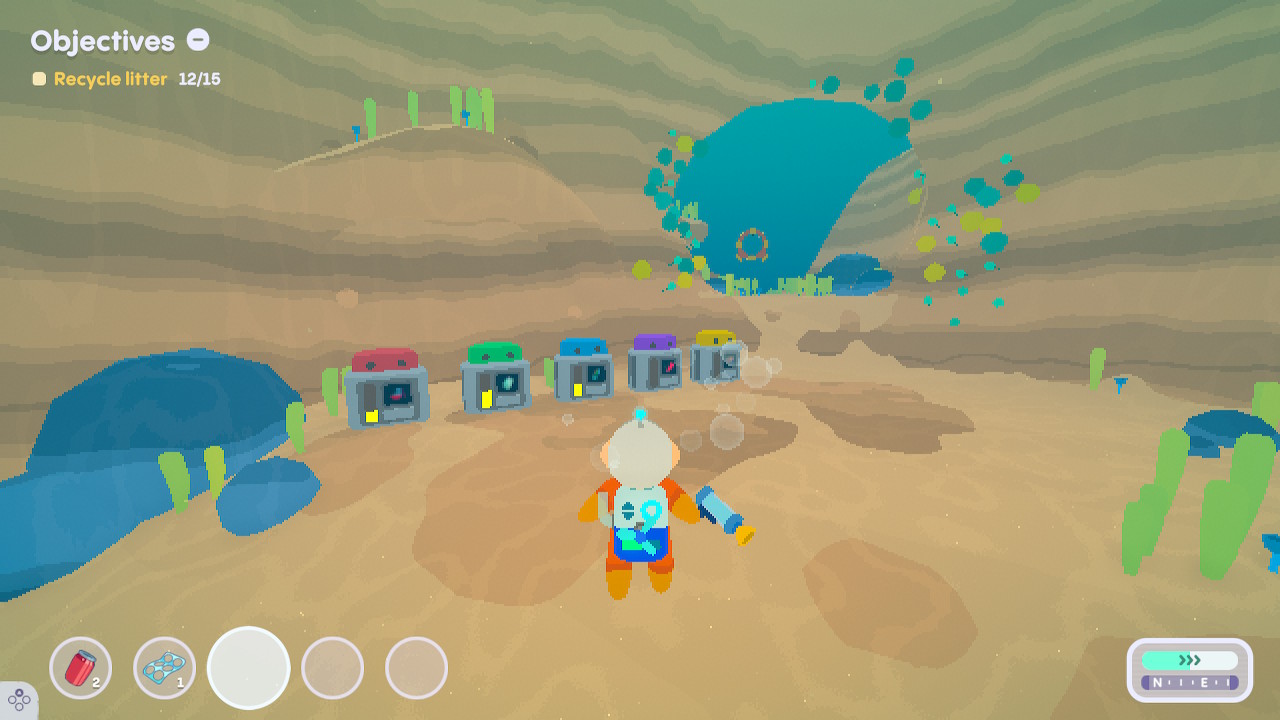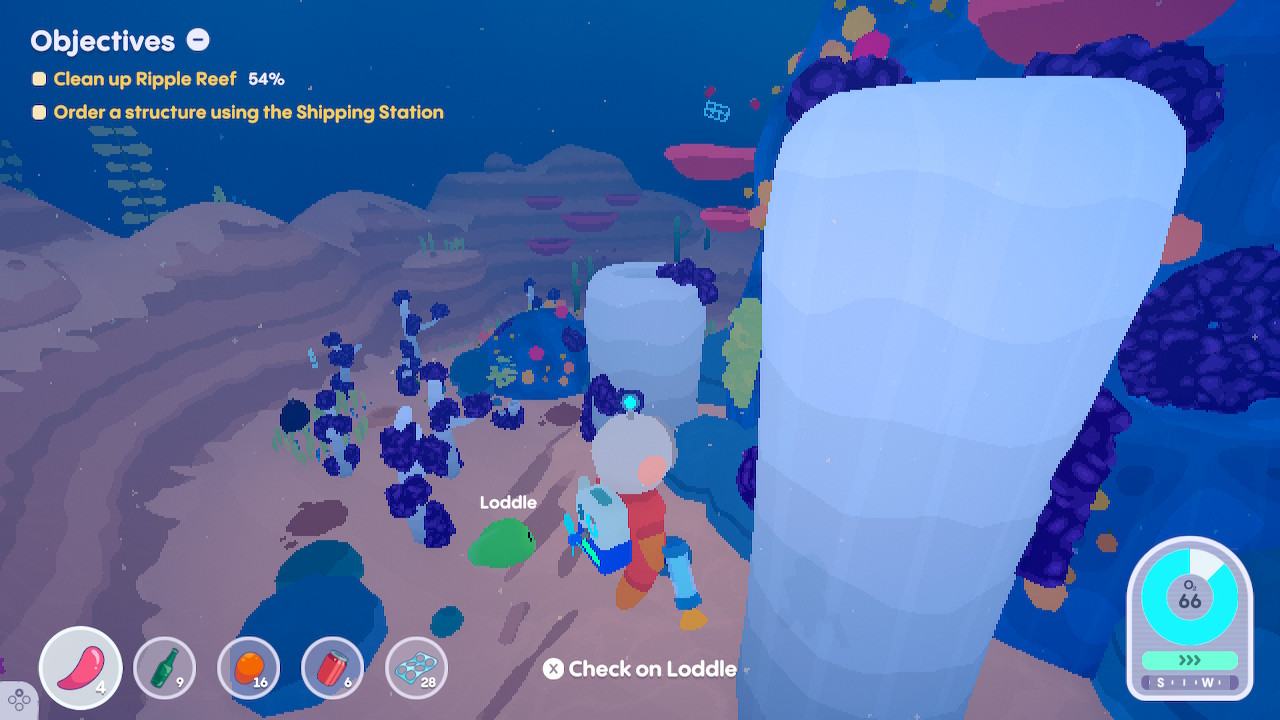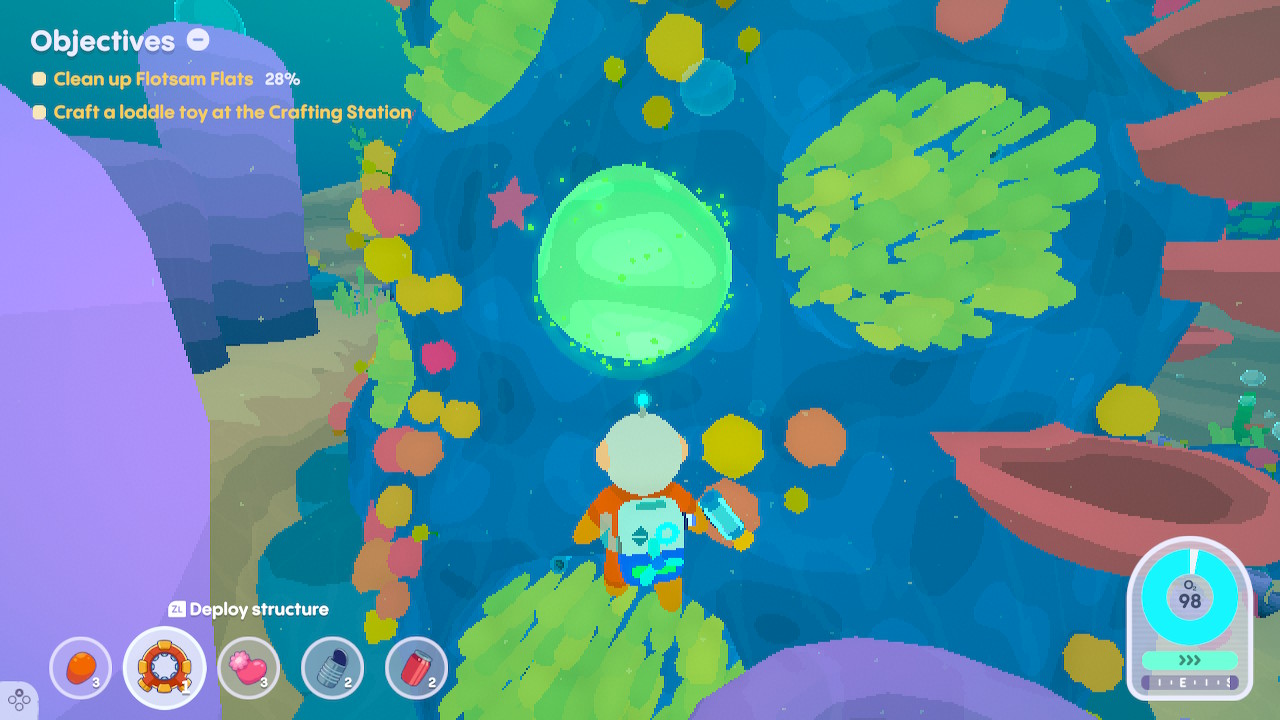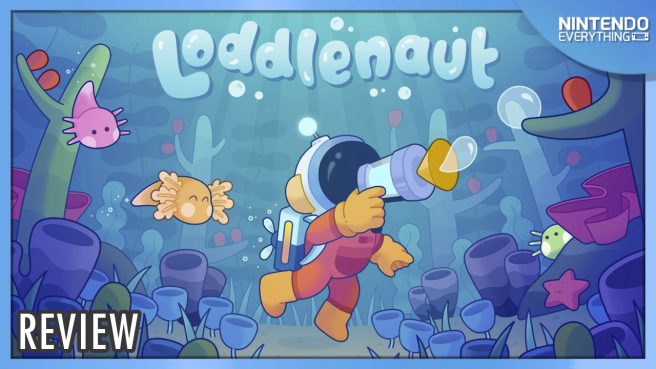[Review] Loddlenaut
System: Switch
Release date: September 19, 2024
Developer: Moon Lagoon
Publisher: Secret Mode
When you stop and think about it, most video games have you cleaning up someone else’s mess. Exactly what that mess is will vary of course: you might have to make sure something you’ve inherited runs smoothly, help people out with their problems, or save a world you just happen to be part of from powers that are generally making life difficult. It’s never a problem you’ve created, but it’s always one that only you can solve. Developer Moon Lagoon’s Loddlenaut follows diligently in the footsteps of the likes of Power Wash Simulator by taking this general concept literally, giving you an aquatic planet to scrub down and some adorable creatures to rescue and nurture along the way.
In Loddlenaut, you are a nameless astronaut-turned-janitor who recently arrived on the planet GUP-14, tasked with cleaning up the substantial mess left behind by the probably-evil megacorporation GUPPI. It’s never made clear exactly what they were doing on the planet, or why they suddenly decided to up and abandon their facilities, but they’ve left the ocean in a very sorry (and in many ways vaguely sinister) state. The plant life is covered in industrial waste, there’s litter everywhere you look, and the entire sea is shrouded in a visible gloom that makes it feel distinctly oppressive.
Although there is no real narrative to speak of, there is some degree of worldbuilding at play, as a handful of employee Holo Badges are scattered around for you to find, which provide some background on what GUPPI might have been doing on the planet and why. These paint quite a disturbing picture both directly and indirectly for their general lack of care and reference to events leading up to your arrival, but for the most part it’s left for you to infer what went on if you choose to. Mostly the game is concerned with damage control, and there is this pervasive sense of futility that I couldn’t help but think about as I was playing it: this corporation had already moved on to another, bigger planet, presumably to repeat the same mistakes. There was no getting rid of the towering structures or inactive robots they’d left behind either, so their mark was irrevocably left on the planet. It didn’t change the relaxing nature of the gameplay, but it did add an odd sense of pathos to it. It’s more than a little at odds with the generally cozy vibe the game is clearly trying to generate if you stop to think about it.
You’re also joined on your mission by a navigator who will occasionally pipe up to helpfully tell you where to go next, things you can do even though it’s “not your job” to do them (such as interacting with the local loddles), and occasionally offer progress updates or words of encouragement. They’ll give you a sense of direction for your work, but no sense on why you’re doing it, and their stance on matters is surprisingly contradictory: after telling me repeatedly that I should be interacting with the loddles by feeding them and playing with them, I was later told off for bringing one back to my Home Cove so I could keep an eye on it. Putting a voice to the objectives given to you in the menu was nonetheless a nice touch that made them feel a little more personal.

Fixing the problems of GUP-14 is a wonderfully calming and blissfully easy experience: all you need to do is go to each area in turn and scrub it down. Being underwater, you have unrestricted 360 degree movement, and the game controls perfectly, letting you easily adjust your height to reach spots that you need to. You also have an oxygen meter to keep an eye on, although I never found this to be as stressful as I was anticipating: passing through manually constructed rings will completely refill it, many cleaned plants will expel oxygen bubbles, and the punishment for letting it run out is being deposited back to your Home Cove minus a few items, which are clustered together where you “died” waiting for you to pick them up again. The game has no fail state to speak of, and encourages you to take your time and enjoy the experience. It’s definitely something to keep in mind if you’re expecting a completely stress-free time though, as your oxygen level is initially quite low and you’ll need to do a lot of dashing back and forth between your Home Cove to prevent it from running out.
Initially you’ll only have your Bubble Gun to rely upon, which will automatically target and zap any purple Goop that has affixed itself to surfaces or plant life nearby with a satisfying degree of speed and accuracy. You may need to get slightly closer or adjust your height to make sure you can get everything, but a “close enough” approach will work most of the time to get rid of the small clusters. You’ll later acquire two additional tools to tackle specific obstacles which are slightly less efficient, with one having a finite capacity meaning that you’ll need to empty it, and the other being irritatingly difficult to control at times, but these are introduced later in the game and inject some variety into the proceedings. As the game takes roughly five hours to complete you won’t be spending much time with these however, making their inclusion feel a little more forced.
You can also use the Bubble Gun to collect Litter that is floating around the area, which can then be converted into useful resources back at your Home Cove. As you might expect, these allow you to buy useful (and sometimes necessary) upgrades to your cleaning equipment and general capabilities, such as your oxygen capacity and jetpack boost duration. It’s a nice added incentive to make sure you clean the entire area from top to bottom, giving you a lasting reward on top of the visual changes and general satisfaction you’ll get from seeing the area slowly transform from a gloomy wasteland to a vibrant wilderness as the percentage number ticks up as you progressively remove all toxic elements. Upgrading your gear will make you better at your job, although some resources – most notably micro chips – are initially more difficult to come by than others, meaning you’ll need to be careful with the order you upgrade your gear unless you want to spend a few minutes combing areas for litter for added resources.

As good as it is, it’s admittedly not quite as satisfying as it could be, as areas refuse to stay clean once they’ve hit that magical 100 percent. After a while you’ll find that more litter has inexplicably drifted in from somewhere, goop has affixed itself to your previously pristine plant life again, or a loddle has somehow managed to find itself covered in goop and is now merrily spreading it around, forcing you to abandon what you’re currently doing and traipse back before the situation gets out of hand. It’s an understandable and arguably necessary evil, because a finite amount of litter would mean that you’d be unable to create items to take care of loddles after you’d completely cleaned the planet, but it does rob the game of a degree of satisfaction once you get that 100% rating for an area when you know it’ll drop to 99% again a few minutes after you leave for the next one.
Loddle care is the other main element of the gameplay, although it is not required in any way for progression, being more of a side activity that you can indulge in as you progress. Initially only small, goop-covered blobs that you’ll encounter in each area as you clean them, you can feed loddles, pet them, and create toys for them to play with to influence their growth and change their form to something a bit more interesting. If you’ve ever owned a Tamagotchi or other virtual pet you’ll be familiar with the format here, and there is a handy “Loddlepedia” available in the menu that documents which ones you’ve successfully raised, as well as their unique characteristics. It’s a fun break from cleaning that adds some longevity to the game if you choose to engage with it, and makes you feel as though you’re re-populating the seabed rather than just cleaning it up, but it can be quite tricky to get specific forms and there isn’t much reward for doing it outside of the satisfaction of filling out the Loddlepedia and having a cute and cuddly creature follow you around diligently whenever you swim past them.

Loddlenaut has a delightfully simple visual style that uses lighting and color to its advantage to give you an added layer of visual feedback as you progress: when you first enter them, areas are visibly gloomier and cast with an almost oppressive purple hue. Removing the Goop and Little will see the area become steadily lighter, until eventually it transforms into a vibrant landscape of lush plant life bathed in a radiant ocean teal glow. There are three levels of pixelation, although I personally found that having it set to anything other than the lowest possible detracted from the visual splendor; your mileage may vary here. The simplicity works in its favor however, as it is easy to spot anomalous elements (and the radar will helpfully highlight things you may miss) and the draw distance is quite impressive. It’s as pleasant to look at as it is to play.
The Verdict

Although I would say it falls just shy of being a truly “cozy” experience due to a few design choices that mean you won’t be able to switch your brain off entirely while you’re playing, Loddlenaut is still a fundamentally relaxing and mostly satisfying experience. It doesn’t really feel long enough to have needed the added tamagotchi element of loddle raising to distract from the core cleaning gameplay, but it’s a nice diversion nonetheless that adds a little life to the title and sets it apart from other games with similar gameplay. It’s an easy recommendation to make if you want something simple to idle away a few hours.
A copy of Loddlenaut was provided by the publisher for the purpose of this review.
